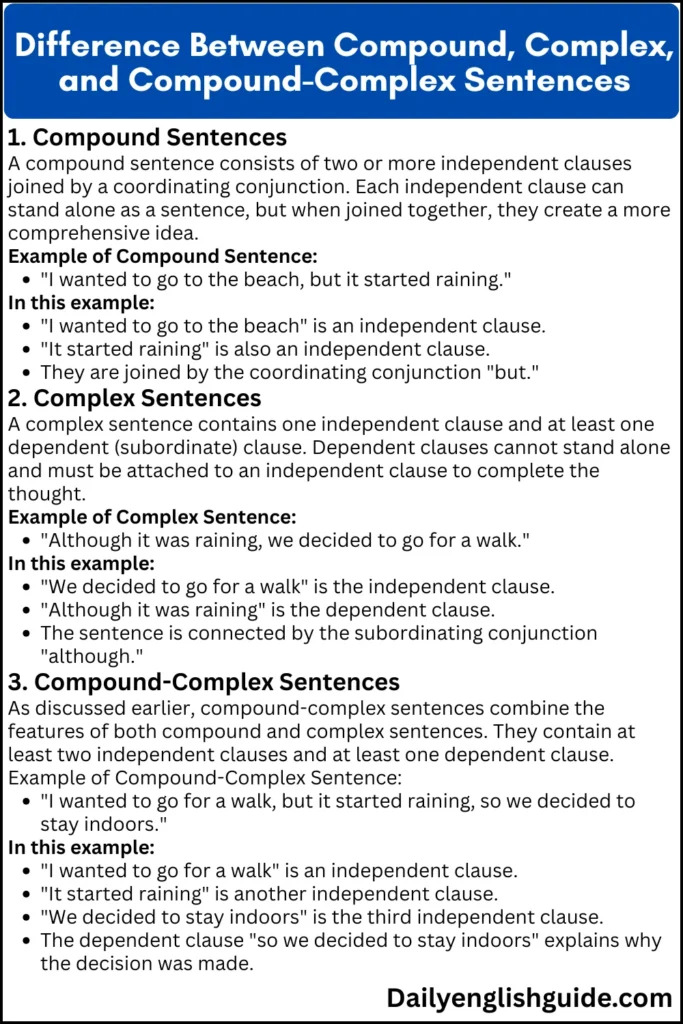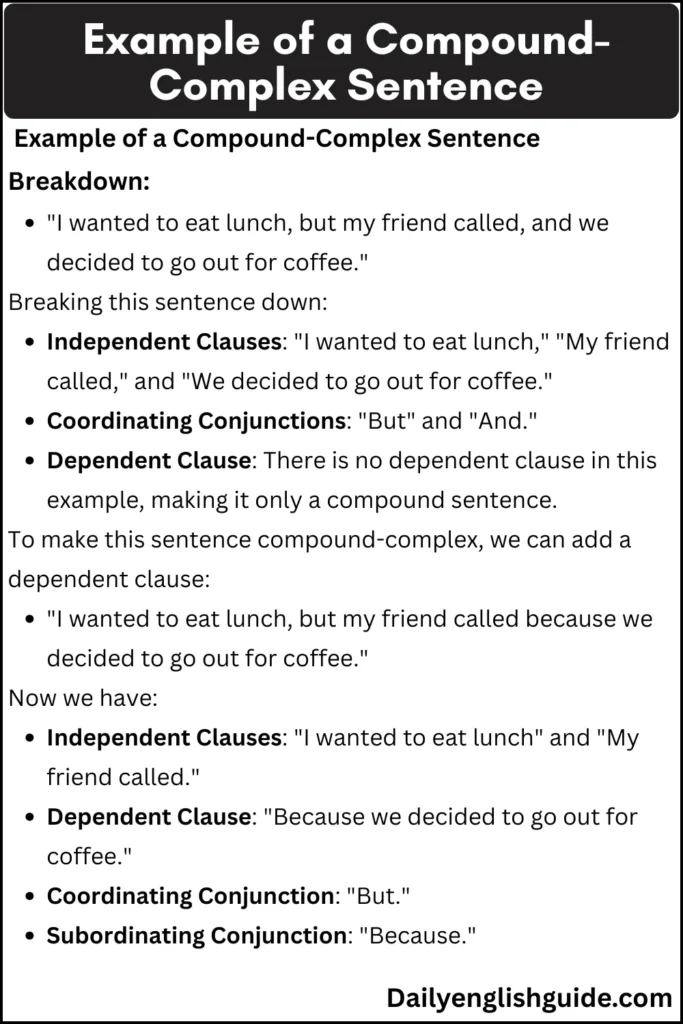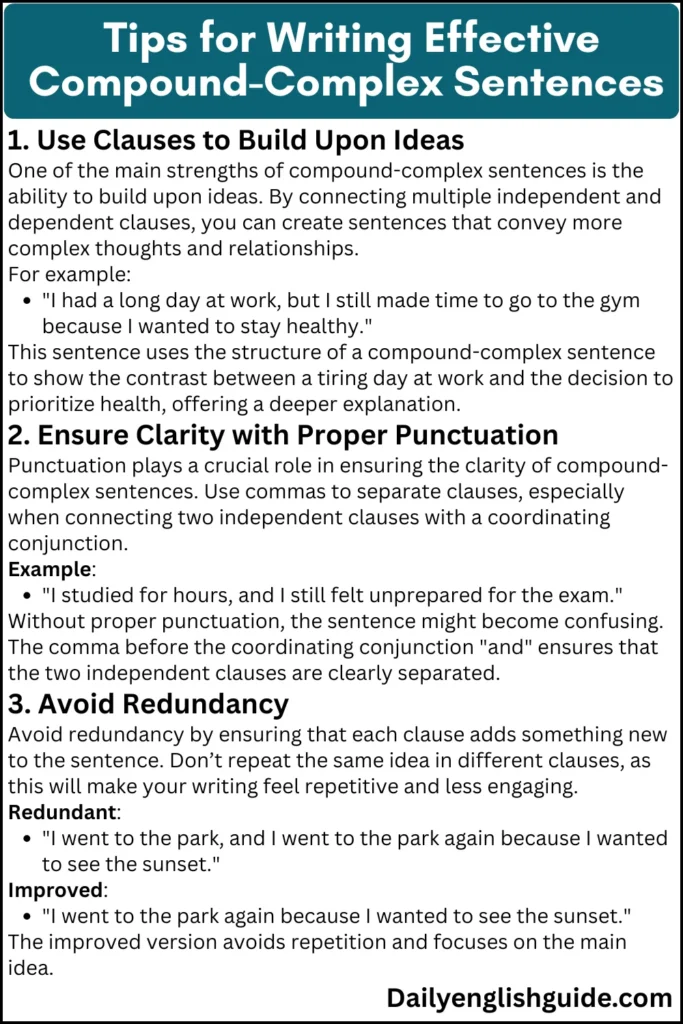In English grammar, understanding the structure and use of sentences is fundamental. Sentences can be classified into various types based on their structure and the relationship between their clauses. Among these, compound-complex sentences are an essential aspect that combines the features of both compound and complex sentences. This article will guide you through the concept of compound-complex sentences, explaining their structure, usage, and how to differentiate them from other types of sentences.
What Are Compound-Complex Sentences?
A compound-complex sentence is a sentence that contains at least two independent clauses and at least one dependent (subordinate) clause. This type of sentence combines the features of both compound sentences and complex sentences, giving it a richer structure and more nuanced meaning. The independent clauses in a compound-complex sentence are joined by coordinating conjunctions, while the dependent clauses are connected to independent clauses through subordinating conjunctions.
Key Characteristics of Compound-Complex Sentences:
-
Independent Clauses: These are clauses that can stand alone as complete sentences. They have both a subject and a predicate, making them grammatically independent.
-
Dependent Clauses: These clauses cannot stand alone as sentences. They depend on an independent clause for their meaning and are typically introduced by subordinating conjunctions (like “because,” “although,” “if,” etc.).
-
Coordinating Conjunctions: These words (such as “and,” “but,” “or,” “so,” etc.) join the independent clauses in the sentence.
-
Subordinating Conjunctions: These words (like “because,” “although,” “while,” etc.) connect the dependent clauses to the independent clauses.
Structure of Compound-Complex Sentences
A compound-complex sentence may look like this:
-
Independent Clause + Coordinating Conjunction + Independent Clause + Subordinating Conjunction + Dependent Clause
For example:
-
“I wanted to go to the park, but it started raining before we left.”
Here, the sentence has:
-
Two independent clauses: “I wanted to go to the park” and “it started raining.”
-
A coordinating conjunction: “but.”
-
One dependent clause: “before we left.”
The above example clearly illustrates how a compound-complex sentence contains both independent and dependent clauses, connected in a way that makes the sentence rich and more informative.

Difference Between Compound, Complex, and Compound-Complex Sentences
While compound-complex sentences may seem intricate, it’s essential to distinguish them from simple compound sentences and complex sentences. Let’s break down the differences so you can grasp the unique structure of compound-complex sentences.
1. Compound Sentences
A compound sentence consists of two or more independent clauses joined by a coordinating conjunction. Each independent clause can stand alone as a sentence, but when joined together, they create a more comprehensive idea.
Example of Compound Sentence:
-
“I wanted to go to the beach, but it started raining.”
In this example:
-
“I wanted to go to the beach” is an independent clause.
-
“It started raining” is also an independent clause.
-
They are joined by the coordinating conjunction “but.”
2. Complex Sentences
A complex sentence contains one independent clause and at least one dependent (subordinate) clause. Dependent clauses cannot stand alone and must be attached to an independent clause to complete the thought.
Example of Complex Sentence:
-
“Although it was raining, we decided to go for a walk.”
In this example:
-
“We decided to go for a walk” is the independent clause.
-
“Although it was raining” is the dependent clause.
-
The sentence is connected by the subordinating conjunction “although.”
3. Compound-Complex Sentences
As discussed earlier, compound-complex sentences combine the features of both compound and complex sentences. They contain at least two independent clauses and at least one dependent clause.
Example of Compound-Complex Sentence:
-
“I wanted to go for a walk, but it started raining, so we decided to stay indoors.”
In this example:
-
“I wanted to go for a walk” is an independent clause.
-
“It started raining” is another independent clause.
-
“We decided to stay indoors” is the third independent clause.
-
The dependent clause “so we decided to stay indoors” explains why the decision was made.
How to Identify Compound-Complex Sentences
Identifying compound-complex sentences might seem daunting at first, but with practice, it becomes easier. To accurately identify them, you need to recognize both independent and dependent clauses, as well as the conjunctions that connect them.
Steps to Identify Compound-Complex Sentences:
-
Look for Independent Clauses:
First, identify the independent clauses in the sentence. These clauses must have a subject and a verb, and they can stand alone as complete sentences. -
Find the Dependent Clause:
Next, find the dependent clause. This clause will also have a subject and verb, but it cannot stand alone. It will often start with a subordinating conjunction (like “because,” “since,” “if,” etc.). -
Check for Conjunctions:
Look for conjunctions that connect the clauses:-
Coordinating conjunctions (for, and, nor, but, or, yet, so) will join independent clauses.
-
Subordinating conjunctions (although, because, if, when, while, etc.) will join the dependent clause to an independent clause.
-
-
Check for Multiple Independent Clauses:
Ensure that there are at least two independent clauses. If there’s only one independent clause, the sentence might be a simple sentence or a complex sentence.

Example of a Compound-Complex Sentence Breakdown:
-
“I wanted to eat lunch, but my friend called, and we decided to go out for coffee.”
Breaking this sentence down:
-
Independent Clauses: “I wanted to eat lunch,” “My friend called,” and “We decided to go out for coffee.”
-
Coordinating Conjunctions: “But” and “And.”
-
Dependent Clause: There is no dependent clause in this example, making it only a compound sentence.
To make this sentence compound-complex, we can add a dependent clause:
-
“I wanted to eat lunch, but my friend called because we decided to go out for coffee.”
Now we have:
-
Independent Clauses: “I wanted to eat lunch” and “My friend called.”
-
Dependent Clause: “Because we decided to go out for coffee.”
-
Coordinating Conjunction: “But.”
-
Subordinating Conjunction: “Because.”
Common Mistakes in Using Compound-Complex Sentences
While compound-complex sentences are useful for creating more detailed and nuanced statements, they can be tricky to use correctly. Understanding and avoiding common mistakes can help improve the clarity and effectiveness of your writing. Below are some common errors people make when using compound-complex sentences and how to avoid them.
1. Overuse of Conjunctions
One common mistake is the overuse of conjunctions. Although conjunctions are essential for connecting clauses, using too many in one sentence can make it feel cluttered and hard to follow. Ensure that each conjunction serves a clear purpose and avoid joining too many clauses in one sentence.
Incorrect:
-
“I wanted to go to the store, but I was too tired, and it was too late, so I decided to stay home.”
Improved:
-
“I wanted to go to the store, but I was too tired, so I decided to stay home.”
By reducing the number of conjunctions, the sentence becomes more concise and easier to understand.
2. Confusing Independent and Dependent Clauses
Another mistake is confusing independent and dependent clauses, especially when dependent clauses are mistakenly treated as independent. Remember, dependent clauses cannot stand alone and need an independent clause to complete the thought.
Incorrect:
-
“Because I forgot my keys, I went back to the car, and I had to get them.”
Improved:
-
“Because I forgot my keys, I went back to the car to get them.”
By properly placing the dependent clause at the beginning and linking it to the independent clause, the sentence flows more naturally.
3. Incorrect Use of Punctuation
Punctuation is crucial in compound-complex sentences, especially when separating independent clauses. A comma or semicolon is often needed before coordinating conjunctions to ensure clarity.
Incorrect:
-
“I wanted to go to the beach but it started raining.”
Improved:
-
“I wanted to go to the beach, but it started raining.”
In compound-complex sentences, always place a comma before the coordinating conjunction when linking two independent clauses. A semicolon can also be used instead of a comma in certain cases for a stronger separation between clauses.
4. Overcomplicating Sentences
One of the pitfalls of compound-complex sentences is the temptation to overcomplicate them with too many clauses. While variety in sentence structure is important, overly long sentences with multiple clauses can confuse the reader. Aim for clarity and precision, breaking up overly complex sentences into smaller ones if needed.
Incorrect:
-
“I woke up early because I had an important meeting at work, and I had to prepare all the documents, but I also had to drop my kids off at school, and I was running late, so I had to rush through everything.”
Improved:
-
“I woke up early because I had an important meeting at work. I also had to prepare all the documents and drop my kids off at school, so I was running late and had to rush through everything.”
Breaking the sentence into two or more parts makes it easier to read and understand.

Tips for Writing Effective Compound-Complex Sentences
Writing effective compound-complex sentences can elevate your writing and make it more engaging and varied. Below are some tips to help you craft clear and impactful compound-complex sentences.
1. Use Clauses to Build Upon Ideas
One of the main strengths of compound-complex sentences is the ability to build upon ideas. By connecting multiple independent and dependent clauses, you can create sentences that convey more complex thoughts and relationships.
For example:
-
“I had a long day at work, but I still made time to go to the gym because I wanted to stay healthy.”
This sentence uses the structure of a compound-complex sentence to show the contrast between a tiring day at work and the decision to prioritize health, offering a deeper explanation.
2. Ensure Clarity with Proper Punctuation
Punctuation plays a crucial role in ensuring the clarity of compound-complex sentences. Use commas to separate clauses, especially when connecting two independent clauses with a coordinating conjunction.
Example:
-
“I studied for hours, and I still felt unprepared for the exam.”
Without proper punctuation, the sentence might become confusing. The comma before the coordinating conjunction “and” ensures that the two independent clauses are clearly separated.
3. Avoid Redundancy
Avoid redundancy by ensuring that each clause adds something new to the sentence. Don’t repeat the same idea in different clauses, as this will make your writing feel repetitive and less engaging.
Redundant:
-
“I went to the park, and I went to the park again because I wanted to see the sunset.”
Improved:
-
“I went to the park again because I wanted to see the sunset.”
The improved version avoids repetition and focuses on the main idea.
4. Balance the Sentence Structure
A well-balanced sentence structure is essential in compound-complex sentences. Ensure that the independent clauses are of similar length and that the dependent clause contributes to the sentence without overwhelming it.
Unbalanced:
-
“I went to the store to buy groceries because we needed food, and I was also hoping to get some fresh flowers for the house, which I had been thinking about for weeks.”
Balanced:
-
“I went to the store to buy groceries because we needed food, and I also picked up some fresh flowers for the house.”
The improved version balances the length of the independent clauses, making it clearer and easier to follow.
Conclusion
In conclusion, compound-complex sentences are an essential part of the English language that allow writers to combine multiple ideas and provide more context in a single sentence. By mastering the structure of these sentences, you can create writing that is more varied, nuanced, and engaging. Remember to focus on clarity, avoid redundancy, and use punctuation correctly to enhance the effectiveness of your compound-complex sentences.
